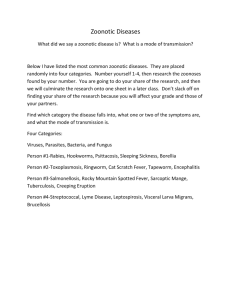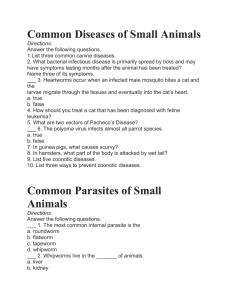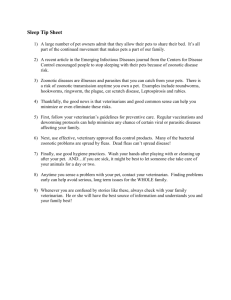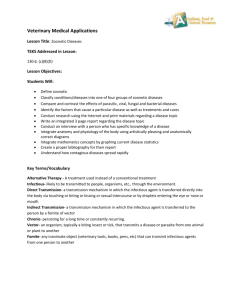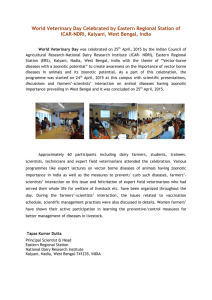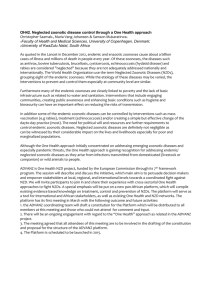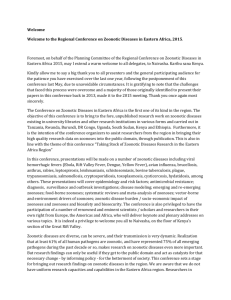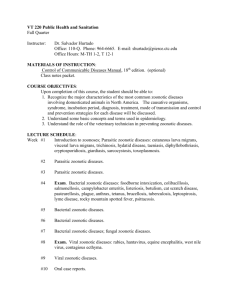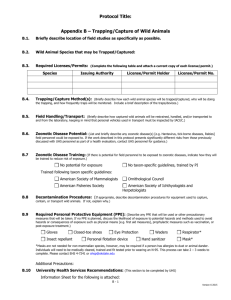What is a zoonotic disease?
advertisement
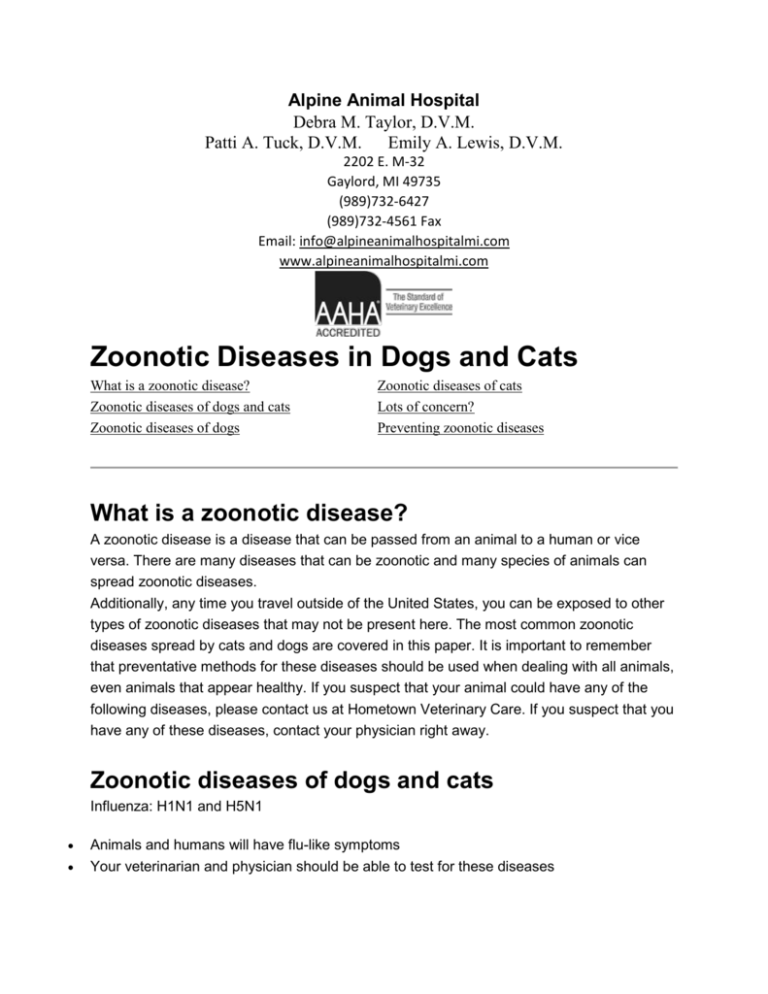
Alpine Animal Hospital Debra M. Taylor, D.V.M. Patti A. Tuck, D.V.M. Emily A. Lewis, D.V.M. 2202 E. M-32 Gaylord, MI 49735 (989)732-6427 (989)732-4561 Fax Email: info@alpineanimalhospitalmi.com www.alpineanimalhospitalmi.com Zoonotic Diseases in Dogs and Cats What is a zoonotic disease? Zoonotic diseases of dogs and cats Zoonotic diseases of dogs Zoonotic diseases of cats Lots of concern? Preventing zoonotic diseases What is a zoonotic disease? A zoonotic disease is a disease that can be passed from an animal to a human or vice versa. There are many diseases that can be zoonotic and many species of animals can spread zoonotic diseases. Additionally, any time you travel outside of the United States, you can be exposed to other types of zoonotic diseases that may not be present here. The most common zoonotic diseases spread by cats and dogs are covered in this paper. It is important to remember that preventative methods for these diseases should be used when dealing with all animals, even animals that appear healthy. If you suspect that your animal could have any of the following diseases, please contact us at Hometown Veterinary Care. If you suspect that you have any of these diseases, contact your physician right away. Zoonotic diseases of dogs and cats Influenza: H1N1 and H5N1 Animals and humans will have flu-like symptoms Your veterinarian and physician should be able to test for these diseases Methicillin Resistant Staphylococcus Aureus (MRSA) Encompasses the Staph infections which are resistant to a lot of antibiotics Can be spread from pet to human and human back to pet quite easily Regular minor staph infections are generally not contagious Most common infections are of the skin, soft-tissue and surgical sites Dog and cat bites can cause infection Watch for redness, swelling and pain at the infection site- can develop into bloodstream infections and pneumonia Children tend to be more susceptible Rabies Transmitted to humans from the saliva of a rabid animal It is important to consult your physician if you are bitten by any animal- even your pet Rabies is a viral infection that affects the nervous system and is deadly if gone untreated All species are susceptible to rabies- most common wild animals that are carriers are raccoons, coyotes, foxes, and bats Ringworm Ringworm is a fungus spread by direct contact that causes skin and scalp issues Skin often becomes scaly, dry, reddish and itchy Additionally, if it is located in an area that is typically haired, the hair will often fall out Lesion is often circular appearing if present, however cats can be ‘inapparent carriers’ and show absolutely no lesions. Salmonellosis This is a bacterial infection that causes diarrhea, fever and abdominal cramps in humans Symptoms can last up to one week Some recover without treatment, while others have died from the disease To avoid this disease it is important to keep your animals stools picked up and wash your hands immediately after handling their stools Toxocariasis Infection caused by a parasite called the roundworm Can cause eye lesions that can lead to blindness or swelling of organs in the body Zoonotic diseases of dogs Leptospirosis Bacteria spread through urine of infected animals Animal symptoms include fever, vomiting, abdominal pain, diarrhea, refusal to eat, severe weakness, depression, renal disease and liver dysfunction Humans will exhibit flu-like symptoms and if pregnant, this disease can cause a female to abort Antibiotics are used to treat this disease Giardiasis This is caused by an intestinal parasite Transmitted be contaminated stools and water Most common symptom is diarrhea Other diseases include: Cryptosporidosis, Lyme Disease, Brucellosis, Campylobacteriosis, Tapeworm infection, Hookworm infection and several others Zoonotic diseases of cats Cat Scratch Disease This is a bacterial disease that can cause swollen lymph nodes, fever, headache, fatigue, and decreased appetite in the affected human Most cats never show any symptoms of being infected with this disease Transmitted by cat scratches and bites Wash any scratches or bite wounds immediately and avoid rough play with kittens and cats Toxoplasmosis This is one of the most common small animal zoonotic diseases contracted in the world Transmission is through contact with infected cat feces (after 2 or more days outside of the cat’s body) or by eating undercooked meat Symptoms in humans range from nothing to flu-like symptoms- it can cause birth defects and miscarriages in pregnant women Regular litter box cleaning in which cat feces does not sit around for days or weeks eliminates most all risk Other diseases include: Tapeworm infections, Leptospirosis and several other diseases Lots of concern? No, not really. After reading this list you may wonder if it even makes sense to own a pet! Yes, absolutely it does. Though this list is long, zoonotic diseases are uncommon. But you cannot ‘know’ about these conditions if you have not ‘heard,’ and you cannot be proactive about you and your pet’s health without educating yourself. The saying ‘an ounce of prevention is worth a pound of cure’ can not be any more accurate than in zoonotic conditions. When your mother said ‘wash your hands before you eat’, she knew what she was talking about! Preventing zoonotic diseases o o Good Hygiene! Wash your hands thoroughly with hot, soapy water after playing with your pets or handling their waste. Keep feces cleaned up in the yard and litter boxes. Vaccinate and deworm regularly. Contact your physician and veterinarian if you think you or pet could have a zoonotic disease. © 2010 Hometown Veterinary Care
